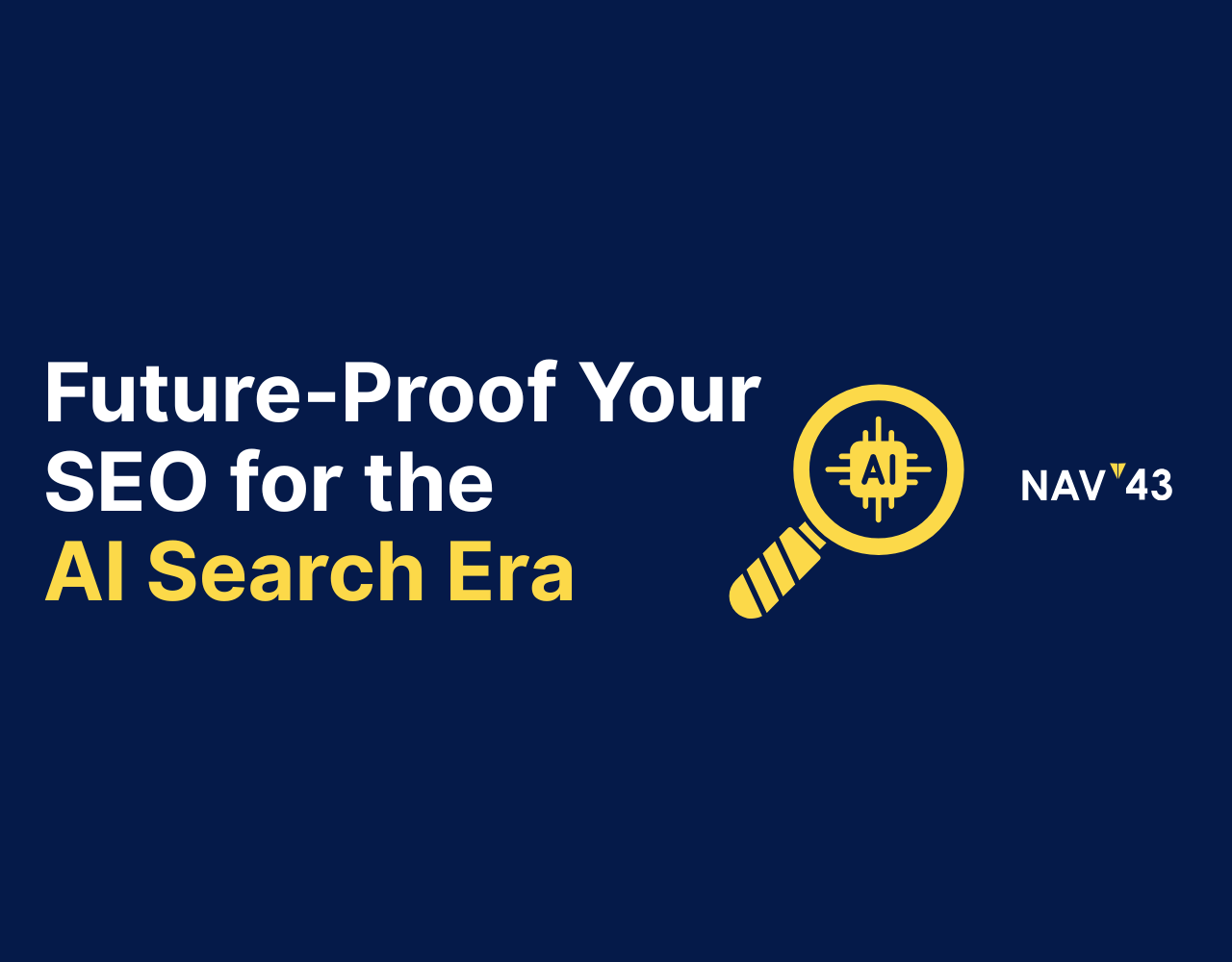
AISO: How to Optimize for AI Search in 2025
The search landscape is evolving at breakneck speed, driven by the rise of artificial intelligence in search engines. As CEO of NAV43, I’ve watched this transformation firsthand, helping clients navigate what might be the most significant shift in search since mobile optimization.
Marketers are now hearing new acronyms like AISO (AI Search Optimization) and SGE (Search Generative Experience), wondering what they mean for their carefully crafted SEO strategies. In essence, AI-powered search is transforming how users find information, and how content creators must optimize. Recent advancements have made powerful AI SEO tools more affordable, providing businesses with accessible and valuable resources to enhance their strategies.
Instead of just ten blue links on a results page, users now see AI-generated summaries, conversational answers, and interactive follow-up questions. This paradigm shift means it’s time for marketers to adapt their SEO strategies for AI-driven results.
In this comprehensive guide, I’ll share what our team at NAV43 has learned about optimizing for AI search. You’ll understand Retrieval-Augmented Generation (RAG), the differences between an LLM’s internal knowledge and real-time search results, and how predictive summaries work. Most importantly, you’ll get actionable strategies to ensure your content still ranks and resonates in the age of AI search.
Introduction to AISO
Artificial Intelligence Search Optimization (AISO) is revolutionizing digital marketing by leveraging the power of artificial intelligence to enhance traditional SEO strategies. Unlike conventional methods, AISO focuses on personalizing search results for individual users, creating a unique experience tailored to their needs, preferences, and habits. This personalized approach not only improves user satisfaction but also drives more organic traffic and boosts search engine performance.
By utilizing AI-powered search technologies, businesses can gain valuable insights into user behavior, allowing them to optimize their content more effectively. The Aiso Library, a comprehensive repository of knowledge on AI and machine learning, serves as a valuable resource for companies looking to implement AISO strategies. This library provides access to the latest research, tools, and best practices, helping businesses stay ahead of the curve.
One of the significant advantages of AISO is its ability to automate complex tasks, such as keyword research and content creation. This automation frees up time for businesses to focus on strategic decision-making and creative development, ultimately enhancing their overall marketing efforts. By embracing AISO, companies can not only improve their search engine rankings but also create a more engaging and personalized experience for their users.
The Rise of AI Search and Its Impact on SEO
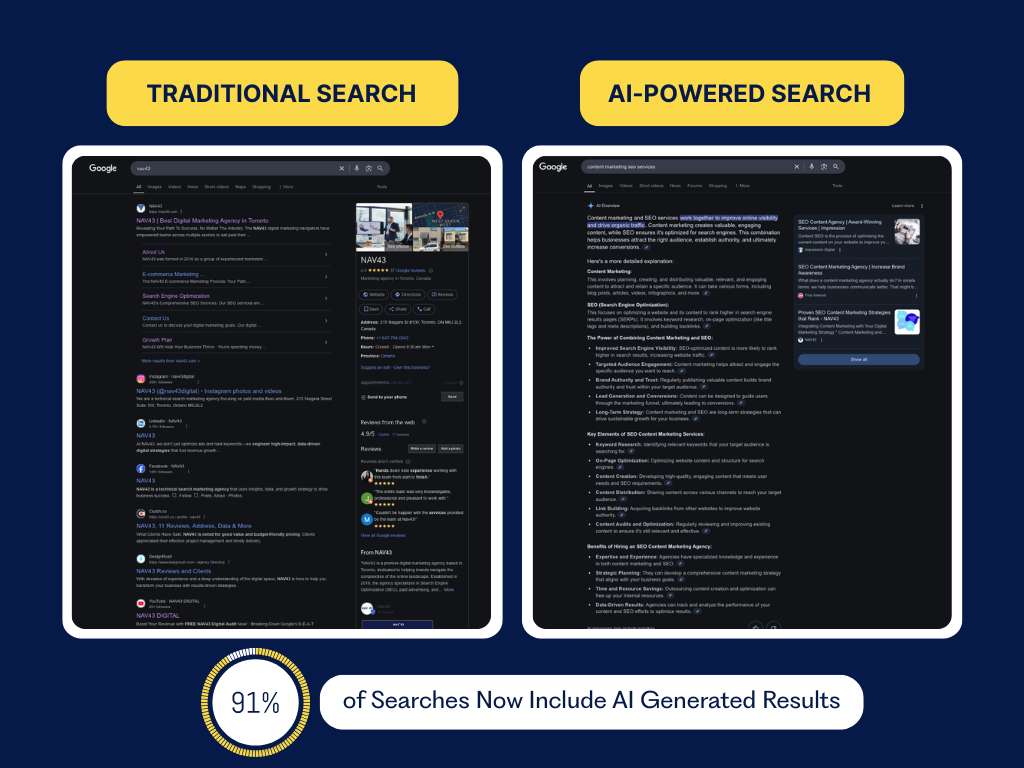
Google’s introduction of Search Generative Experience (SGE) in 2023 marked a revolutionary shift toward more contextual, intuitive search results. Instead of simply listing links, Google’s AI now generates concise overviews at the top of search results.
The numbers are striking – according to recent analysis, Google’s SGE appears for roughly 91% of search queries, meaning only about 1 in 11 searches don’t trigger an AI-generated response. This widespread adoption has huge implications for websites.
While many feared AI summaries would devastate click-through rates, the reality is more nuanced. Yes, users can get answers directly on the search page (potentially reducing clicks for simple queries), but AI search also opens new opportunities.
One of the most interesting findings from our client work is that the sources cited in SGE answers often differ from traditional top results. A whopping 93.8% of links in Google’s AI-generated answers come from completely different URLs than the top 10 organic results.
Let that sink in – a page that might not rank on page one organically could still be pulled into an AI answer box. At NAV43, we’ve seen this phenomenon benefit several clients who created highly specific, question-focused content that perfectly matched user intent, even when they couldn’t compete for page one rankings.
For marketers, the takeaway is clear: optimizing for AI search (AISO) requires us to continue focusing on content relevance and quality, because AI may choose authoritative, context-rich content from anywhere on the web.
At the same time, brands need to be mindful of brand protection. Early data suggests AI summaries sometimes pull in competitor content for queries about your brand or product. Maintaining strong brand presence and authoritative content on your own site is crucial so AI results source your information (not a competitor’s) when users seek answers about your brand.
Understanding AI Powered Search
AI-powered search represents a significant leap forward in search technology, utilizing natural language processing (NLP) and machine learning algorithms to analyze user behavior and deliver highly personalized search results. Unlike traditional search models that rely heavily on keyword-based searches, AI-powered search prioritizes relevance and user experience, often outperforming conventional methods.
This advanced technology can help businesses identify the sweet spot in their marketing strategy, balancing great control and enough power to drive conversions. By leveraging AI-powered search, companies can create a great paddle-like experience for their users, offering a lightweight and easy-to-use interface that provides a great feel and precision. This approach ensures that users find exactly what they are looking for, enhancing their overall experience.
The future of search is undoubtedly AI-powered, and businesses that adopt this technology early will gain a competitive advantage in the market. By understanding and implementing AI-powered search, companies can stay ahead of the curve, providing their users with a superior search experience that combines great control, precision, and power.
Key Factors in AISO
Several key factors contribute to the success of AISO, starting with the use of AI-powered search technologies. These technologies enable businesses to implement technical optimization strategies that enhance their content’s visibility and relevance. Measuring success through data-driven metrics is also crucial, as it allows companies to evaluate the effectiveness of their AISO strategies and make necessary adjustments.
One important aspect to consider is the swing weight of your content. Ensuring that your content is balanced and easy to consume, with a great spin that engages users, is essential. The Aiso Centric approach to AISO emphasizes creating a great paddle-like experience for users, focusing on control, precision, and power. This approach ensures that users have a seamless and enjoyable experience, encouraging them to take action.
By automating complex tasks and gaining valuable insights into user behavior, businesses can develop a weighted approach to AISO that prioritizes the needs and preferences of their target audience. Integrating AI-powered search technologies with other business systems and services is critical to the success of AISO, enabling companies to create a seamless and personalized experience for their users.
LLMs vs. Real-Time Search: Where Do AI Answers Come From?
To optimize for AI search, it helps to understand how these AI answers are generated. Modern search AI relies on large language models (LLMs) – the same technology behind ChatGPT – but with a critical difference in how they access information.
AI-powered search technologies have revolutionized the way the internet is organized and accessed, making it easier for users to find relevant information quickly.
LLM Internal Knowledge vs. External Data
A standalone LLM (like the vanilla ChatGPT model) has an internal knowledge base limited to its training data and cutoff date. It doesn’t automatically know about content published after that cutoff, nor can it browse the web on its own.
In contrast, a search engine like Bing’s AI chat or Google’s SGE links the LLM to real-time search results. When you ask a question, the AI pulls in current information from the web rather than relying solely on its memory.
For example, OpenAI’s ChatGPT recently added a Bing-powered browsing mode to fetch live information, combining the fluent, direct answer of an AI with fresh, cited web data.
The implementation of AI search technologies in modern search engines allows for the integration of real-time data with AI-generated responses, enhancing the overall user experience.
In practice, blending an LLM with search gives users the best of both worlds: the convenience of a direct AI answer plus the accuracy of up-to-date info (with sources).
Implications for SEO
Because these AI search models pull data from the live web, traditional SEO factors still matter – your content must be visible and relevant for the AI to find it.
One pattern we’ve consistently observed with our NAV43 clients is that AI answers often synthesize information from multiple pages. If your content is well-optimized and highly relevant to the query, it’s more likely to be chosen as part of the AI’s answer.
Making sure your site is crawlable, indexed, and authoritative on your topic remains fundamental for being included in AI-generated results. An AI can’t magically generate facts that aren’t in its index. It will pull from the topically relevant pages it can find.
This means your keyword strategy should now include the phrasing of actual questions people ask, and your content should directly answer those questions. By doing solid SEO to rank or be relevant for those queries, you increase your chances of being referenced by the AI answer.
Retrieval-Augmented Generation (RAG): How AI Pulls Relevant Information
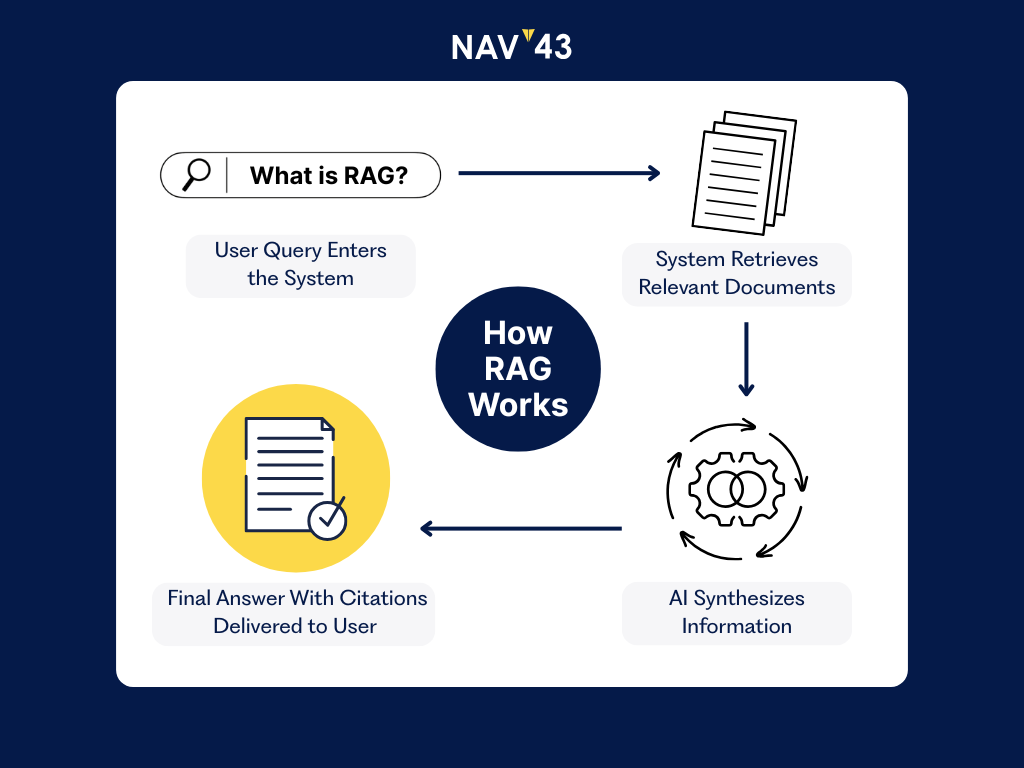
When we talk about AI search using real-time data, we’re often referring to Retrieval-Augmented Generation (RAG). RAG is the process that powers many AI-driven search experiences, and understanding it helps you optimize more effectively.
Here’s how it works in simple terms: when a user asks a question, the system performs a traditional search behind the scenes to retrieve a batch of relevant documents or snippets. Then the AI’s language model augments its answer by drawing on those retrieved texts, essentially generating a summary that cites the source material.
It’s like the AI is reading a handful of web pages for you and then giving you a concise answer. This approach is used by Bing’s AI chat, Google’s SGE, and other tools that give answers with citations.
Instead of the AI guessing an answer solely from its training data, it actively looks up fresh information. The benefit is twofold: the answer can be more accurate and up-to-date, and it can point the user to sources (via links) for more detail.
For marketers and SEO professionals, RAG underscores the importance of relevance and context. The AI will only retrieve and use content that it deems relevant to the query.
In my experience leading SEO strategy at NAV43, this means your content optimization needs to ensure that when the AI’s “mini-search” happens, your pages are among the ones considered. That means having content that clearly answers common questions in your niche, using the language people use when asking those questions.
It also means structuring your content in a way that’s easy for an AI to parse – with descriptive headings, concise explanations, and FAQ sections that align with likely user queries.
Moreover, RAG can level the playing field: even if you’re not the top organic result, if your page contains a highly relevant passage that addresses the query well, the AI might pull from it. In AI search, it’s often about answer segments rather than whole-page ranking.
Predictive Summaries in AI Search Results
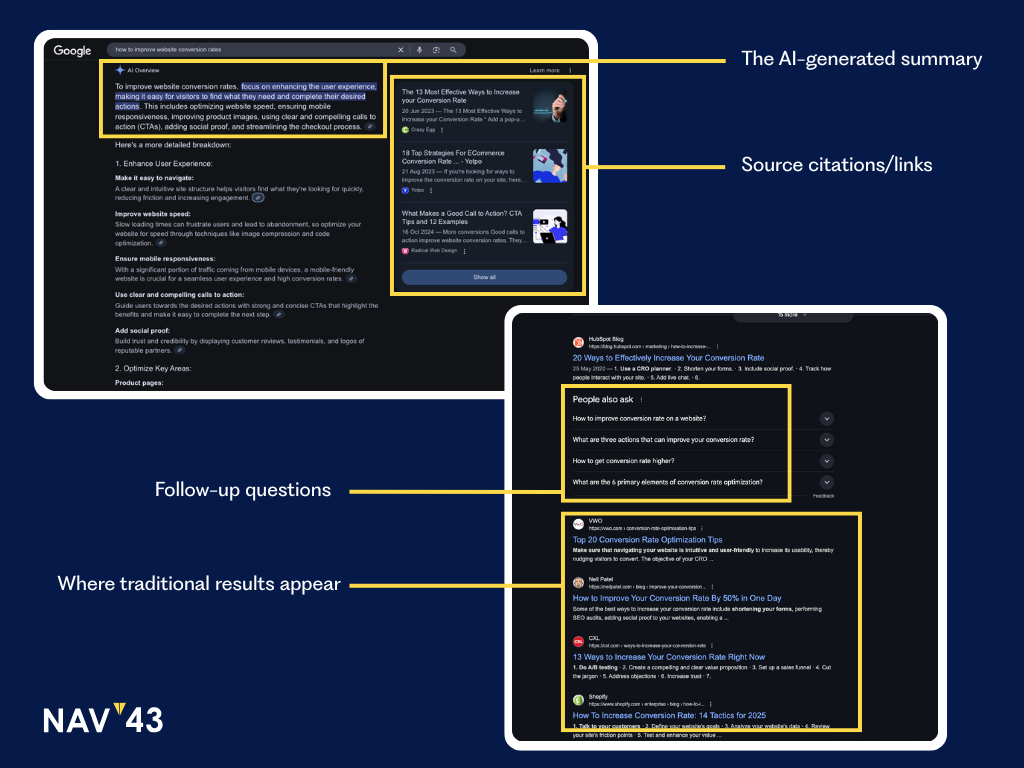
One striking feature of AI-driven search results is the predictive summary – the AI-generated snippet that attempts to answer your question as soon as you search, sometimes even as you’re typing.
These summaries are “predictive” in that the AI uses its trained understanding of language and context to anticipate what information the user is looking for and synthesizes it accordingly. AI technologies support the creation of these predictive summaries by analyzing user queries and relevant content, ensuring that the most pertinent information is delivered efficiently. The AI delivers the most helpful possible response immediately, often pulling together information from multiple sources.
How Predictive Summaries Work
Behind the scenes, once the search engine fetches relevant content (via RAG as described above), the language model evaluates the question and the collected info to draft an answer. It’s essentially predicting the best answer based on probability – stringing together sentences that it believes satisfy the query, informed by the source material.
If the query is straightforward (“What’s the capital of France?”), the AI will confidently answer (“Paris”). For more complex queries, the summary might be a few sentences covering the main points, usually with references linking to the sources.
From an SEO perspective, these AI summaries change how users interact with search results. They provide immediate answers (often reducing clicks for simple queries), but when users do click through an AI summary, it’s usually for more depth or to verify details from the cited sources.
After analyzing dozens of our clients’ search performance data, we’ve found that ensuring your content is structured to be featured in these summaries is key. That means clearly answering likely questions within your content, while providing extra value (details, examples, visuals) so users still have a reason to click through for the full story.
Also, accuracy is paramount. Google and others are likely considering E-E-A-T (Experience, Expertise, Authority, Trustworthiness) signals when deciding which sources to trust in these summaries. High-authority, well-vetted content is less likely to lead the AI astray.
Technical Optimization for AISO
Technical optimization is a critical component of AISO, as it ensures that content is optimized for AI-powered search engines and provides a great user experience. This involves optimizing website structure and content for natural language processing (NLP) and machine learning algorithms. Additionally, all technical elements, such as page speed and mobile responsiveness, must be optimized for search.
Businesses must also consider the data quality and weight of their content, ensuring that it is accurate, up-to-date, and relevant to their target audience. The use of AI-powered tools and software can help businesses automate complex tasks and gain valuable insights into user behavior, enabling them to develop a more effective AISO strategy.
By integrating technical optimization with other AISO strategies, businesses can create a comprehensive and effective approach to search engine optimization that drives real results. This holistic approach ensures that all aspects of AISO are working together to enhance search engine performance and provide a superior user experience.
Why Traditional SEO Practices Still Matter (Even More Now)
Some marketers worry that if AI is doing the heavy lifting for searchers, traditional SEO might become less important. The truth is quite the opposite. Good SEO practices are the foundation of AISO – without them, your content won’t be surfaced for the AI to analyze in the first place.
Optimizing content for AI search requires effort, but this effort pays off in the long run by ensuring your content is effectively analyzed and ranked by AI systems.
Crawlability and Indexing
AI can’t consider your content if it can’t find it. Making sure your site is easily crawlable by search bots (fast load times, proper URL structures, XML sitemap, etc.) is step one. This hasn’t changed in the AI era. If anything, it’s more important, since AI might be querying indexes more frequently for fresh information.
Ensuring crawlability and indexing is like executing baseline drives in a game; it provides a strong foundation for SEO success.
In a recent migration for one of our e-commerce clients, we prioritized crawlability above all else, resulting in 92% of their pages being indexed within two weeks – critical for maintaining visibility in both traditional and AI search.
Relevant Keywords and Topics
Keyword research is still useful, not because you want to stuff keywords, but because you need to speak the language of your audience. AI models determine relevance through semantics – they’re very good at understanding context.
Targeting specific queries is like taking a precise shot in a game, aiming to hit the mark with relevant content.
Ensure your content covers the topics and terms your target users search for. Think in terms of questions and natural language phrases people might use, especially longer conversational queries. This alignment helps your content get picked up by the AI when those questions are asked.
Quality Content and E-E-A-T
As mentioned earlier, demonstrating expertise and trustworthiness is crucial. Google’s algorithms (AI or not) try to favor content that has strong E-E-A-T signals.
Students and professionals alike can benefit from understanding and applying E-E-A-T principles in their content. This knowledge can help students, especially those involved in organizations like the Artificial Intelligence Student Organization (AISO) in Amsterdam, to create authoritative and trustworthy content that stands out.
Continue to publish authoritative content: back up claims with evidence, cite sources, and keep information updated. User engagement signals (like time on page or bounce rate) might also inform AI selection indirectly – if your content is known to satisfy users, it could be deemed a good candidate for an AI summary.
In short, high-quality, trustworthy content is your best long-term SEO (and AISO) strategy.
Structured Data and Snippet Optimization
Using schema markup can help provide context to search engines about your content (for example, marking up FAQs, how-to steps, product details, etc.). While an AI might not directly use schema when generating a summary, structured data can improve your chances of getting rich results or being considered for specific query types. Structured data can enhance user experience, much like how well-designed games keep players engaged.
Additionally, optimizing your content for featured snippets (those direct answer boxes in traditional Google) is a great practice that often aligns with AI summary optimization. If you can grab a featured snippet now, there’s a good chance that content is primed for AI to grab as well.
User Experience and Readability
AI models favor content that is easy to read and parse. This doesn’t mean writing only at a basic level – it means clarity is king. Using clear headings, bullet points, and concise paragraphs not only helps human readers but also allows AI to extract key information more effectively.
Clear and engaging content can make users excited to interact with your site, enhancing their overall experience and satisfaction.
A well-structured page is like giving the AI a neatly organized cheat-sheet to draw from. At NAV43, we’ve consistently found that improving content structure improves performance in both traditional and AI search results.
Actionable AISO Strategies: Optimizing Your Content for AI Search
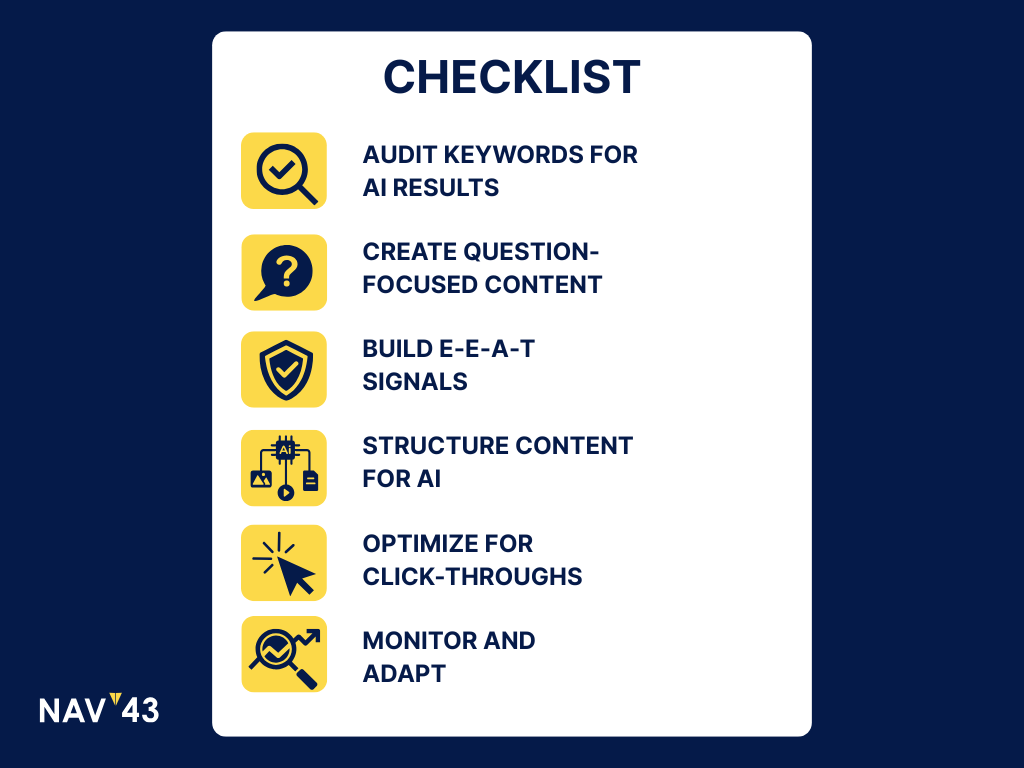
Now that we’ve covered the what and why, let’s jump into the how. Optimizing content for AI search can enhance user experience, making it more enjoyable to play with the search results. Below are key strategies to help you optimize for AI search (AISO) and ensure your content gets featured in AI-generated results:
1. Audit Your Keyword Landscape for AI Results
Start by identifying which of your important keywords or topics are likely to trigger AI-generated answers. Use Google’s SGE (if available in your region) or Bing’s chat results to see what an AI summary looks like for those queries.
Understanding the price of competitive keywords can help in optimizing your content strategy. This audit will highlight where you might lose clicks to an AI answer and where you have opportunities. For example, if an informational query you target is answered directly on the SERP, consider how you can still draw the user in (perhaps by providing a more in-depth or nuanced answer on your site).
Conversely, if you see AI results citing sources that aren’t even top-ranked, that’s a sign you could break in with content targeting that query. Keep a close eye on emerging patterns – one study found SGE triggers on over 90% of queries, so it’s likely many of your keywords are affected.
2. Focus on Question-Focused, High-Value Content
Content that directly answers questions is gold in the world of AI search. Weave common questions and their answers into your content (consider adding an FAQ section on relevant pages). Use natural language in your headings – think about queries like “How do I…”, “What is…”, “Best way to…”, etc., and ensure your content addresses them.
The rise of AI search has elevated the importance of long-tail and conversational queries. Interestingly, some question-and-answer sites (like Quora) have been big winners in SGE, underscoring how much AI values Q&A content.
You can take a page from that: structure some of your content in a Q&A format, or at least make sure to answer the who/what/why/how questions clearly within your text.
3. Double Down on E-E-A-T
In an era when AI might summarize your content to users, you want to be the trusted source it picks. Continue to build your site’s authority in your niche. This includes creating content with first-hand expertise (if you have real experience or data, highlight it), getting credible backlinks and mentions, and showcasing author credentials.
Make sure each important piece of content has an author bio or byline that establishes expertise. Also, keep content fresh – up-to-date information is more likely to be accurate and get used by AI.
High E-E-A-T not only helps with traditional SEO, but it reduces the risk of the AI pulling in incorrect info and associating it with your brand. Remember, Google’s algorithms and AI trust signals of authority, so strive to be the authority that the AI prefers to quote.
4. Structure Your Content for AI Consumption
Think about how an AI model will read your page. Break up long blocks of text with descriptive subheadings that telegraph the key points. Use bullet points or numbered lists for step-by-step guides or key takeaways – these are easy for an AI to digest and may end up as part of a summary.
For instance, if you have an article about “Steps to improve SEO,” a list of those steps could be directly incorporated into an AI answer about that topic. Use tables or charts for data where appropriate (the AI might not show the table but could mention a data point).
Also include images with informative alt text; some AI systems are starting to incorporate image content in answers, so this could be a consideration moving forward.
Organizing your content effectively is like using the right paddles in a game, ensuring smooth and efficient performance.
The bottom line is to make your content modular and scannable – both for humans and AI. If each section of your page delivers a distinct sub-topic or answer, the AI can more easily pull the part it needs to address a specific question.
5. Optimize for Click-Throughs
Being included in an AI summary is only half the battle – you also want users to click through to your site. Encourage clicks by offering additional value beyond the AI snippet.
If the AI provides a quick answer sourced from your content, ensure the page it came from has deeper insights or examples that users can’t get from the summary alone. Also craft compelling, relevant title tags (and meta descriptions) so your organic listing beneath the AI box still attracts attention.
Optimizing for click-throughs can enhance user engagement, much like how well-played strategies keep players invested in a game.
Give searchers a reason to visit your site for the “full story” after reading the AI’s preview. We’ve found that teasing case studies, exclusive data, or visuals in your meta description can significantly boost click-through rates even when an AI summary is present.
6. Monitor and Adapt
AI search is evolving, so your strategy should too. Regularly check how your content is represented in AI results for your important queries. Stay informed on new SGE/Bing changes (like how sources are cited or how often AI results appear).
Ongoing optimization projects can help businesses stay ahead of the curve in AI search. If you see shifts – say AI starts attributing sources more clearly – adjust accordingly (ensure your branding is prominent so any mention benefits you). If some content isn’t getting picked up by AI at all, investigate and refine it.
The key is to remain agile and ready to pivot as AI search features change. At NAV43, we’ve implemented monthly AISO audits for our clients to stay ahead of these rapid developments.
Measuring Success in AISO
Measuring the success of AISO strategies is critical to understanding their effectiveness and identifying areas for improvement. Businesses can use data-driven metrics, such as search engine rankings, organic traffic, and conversion rates, to evaluate the performance of their AISO strategies. These metrics provide valuable insights into how well the strategies are working and where adjustments may be needed.
The use of AI-powered tools and software can further enhance this process by providing deeper insights into user behavior. By tracking key performance indicators (KPIs) and adjusting their AISO strategies accordingly, businesses can ensure that they are getting the most out of their investment in AISO.
The future of AISO is exciting, with new technologies and innovations emerging all the time. Businesses that stay ahead of the curve and continuously adapt their strategies will be well-positioned to succeed in the evolving search landscape. By embracing AISO and leveraging the latest tools and techniques, companies can ensure their marketing efforts remain effective and competitive.
Conclusion: Embracing the Future of Search
AI-driven search is no longer a theoretical concept on the horizon – it’s here now, woven into the search results that millions of people see every day. For marketers and SEO professionals, this shift demands both vigilance and adaptation.
We need to understand how technologies like SGE and RAG are changing the rules, and then adjust our playbook accordingly. The good news is that the core principle remains the same: provide valuable, relevant, and trustworthy content. How that content is delivered may be evolving, but its fundamental value to users is still what ultimately wins.
By optimizing for AI search (AISO), you’re essentially future-proofing your digital presence. You’re ensuring that whether a user finds you via a classic blue link or a conversational AI snippet, your brand’s information is front-and-center and compelling. AI search optimization can help businesses stay on the ball in the evolving search landscape.
Remember that SEO in the age of AI is a two-way street – AI needs great content to deliver great answers. By following the strategies outlined above, you’ll help the AI do its job and help your content get the visibility it deserves.
In the end, those who embrace these changes early will ride the wave of AI-driven search rather than get drowned by it. The search landscape will continue to change, but with a solid understanding of AI’s role and a commitment to high-quality SEO, you can ensure your marketing remains on the cutting edge.
At NAV43, we’re helping clients navigate this transition daily, and I can confidently say that the marketers who master AISO today will be the success stories of search tomorrow.
Ready to optimize your content for AI search? Contact NAV43 today for a personalized AISO strategy that drives real results.
